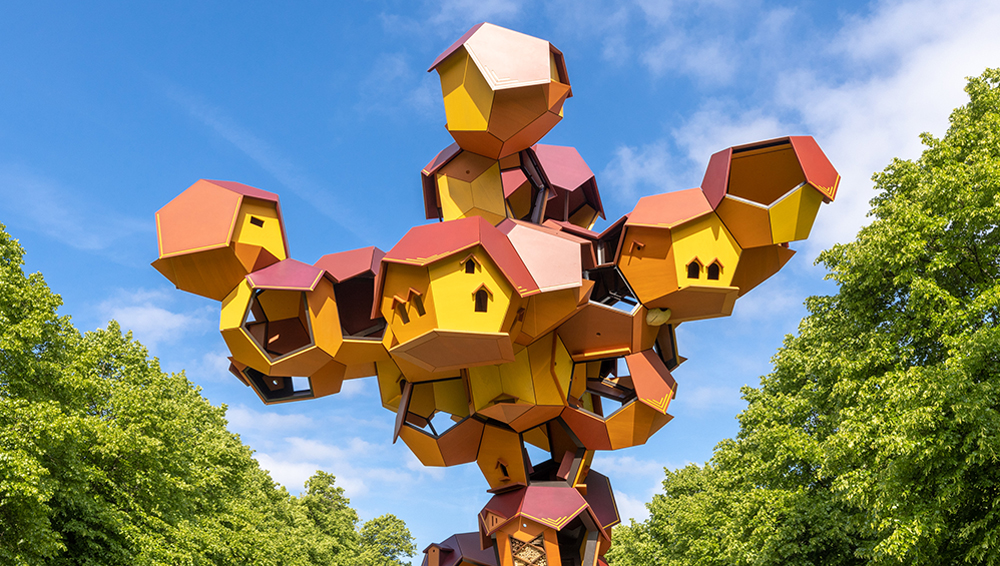
Cloud Cities: Species of Spaces and Other Pieces*, 2023. Installation view at Tomás Saraceno In Collaboration: Web(s) of Life, Serpentine, London, 2023. Photo: Studio Tomás Saraceno.
Serpentine South and the Royal Parks, London
1 June – 10 September 2023
by JOE LLOYD
Spiders know how to pick up vibes. They may have eight eyes, but very few have strong eyesight. Instead, they use hairs on their legs to sense vibrations. Their silken webs work to capture prey and as a sort of alarm system. The Berlin-based Argentinian artist Tomás Saraceno (b1973) has found a way to harness this spider-sense. ArachnoAnacróArcano (2023) wires up a confessional stall with custom microphones that capture the vibrations of spider webs. The gallery text reads: “Spiders inhabiting the gallery may take up residence in place of the priest, offering alternative wisdoms to the cycle of sin and redemption.” There are sculptures of giant spiders on top. But when I enter to confess my environmental sins, I find no arachnid but instead a shimmering web. Occasional tremors give you some idea of what it might be like to be a spider.
Saraceno is the spiderman of contemporary art. An architect by training, his work often draws on the structural ingenuity and formal inventiveness of webs. He has filled the Palais de Tokyo with giant wiry structures, and hung the ceiling of Düsseldorf’s Kunstsammlung K21 with a mesh platform for daring visitors to crawl across (a confession: when I went, I had to have someone to hold my hand). But Saraceno’s interest in webs is also metaphorical. Webs hang from other surfaces, they connect. Their grid-like form has long served as a metaphor for a non-hierarchical ordering of things — remember the world wide web? That they are also sticky traps, woven to wrap up insects ready for eating, goes unremarked on.
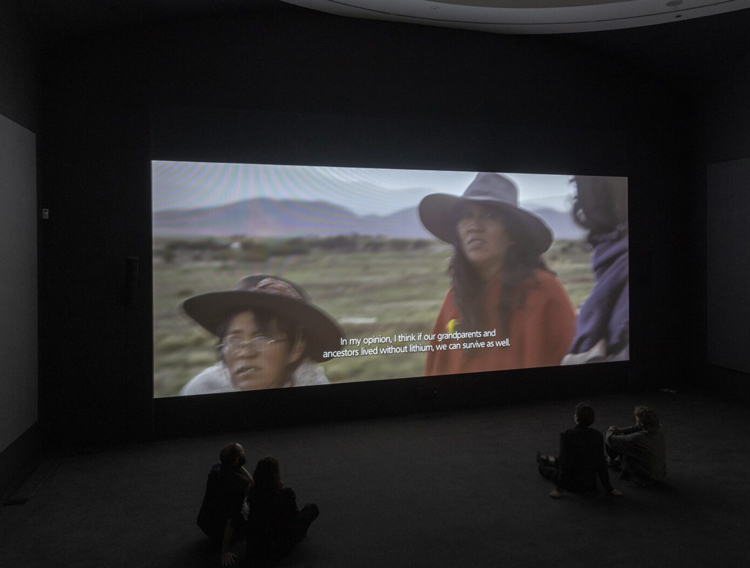
Tomás Saraceno In Collaboration: Web(s) of Life, Serpentine, London, 2023. Photo: Studio Tomás Saraceno.
Web(s) of Life, Saraceno’s survey exhibition at Serpentine South, takes us well and truly into his spiderverse. Saraceno has developed an interdisciplinary network called Arachnophilia, which seeks ways to “connect and converse with arachnid kin”. A video artwork (2019) introduces us to the Cameroonian spider diviner Bollo Pierre Tadios, who is consulted by local people facing a dilemma. Leaves are incised and placed within a spider’s clay pot. The way in which a spider manipulates them provides the answer to an inquiry. You are encouraged to visit nggamdu.org to submit a query, for a small fee that goes to support the community; the answers will be screened during the exhibition. There is some magic in this connection across the planet, and Saraceno’s preservation of a tradition.
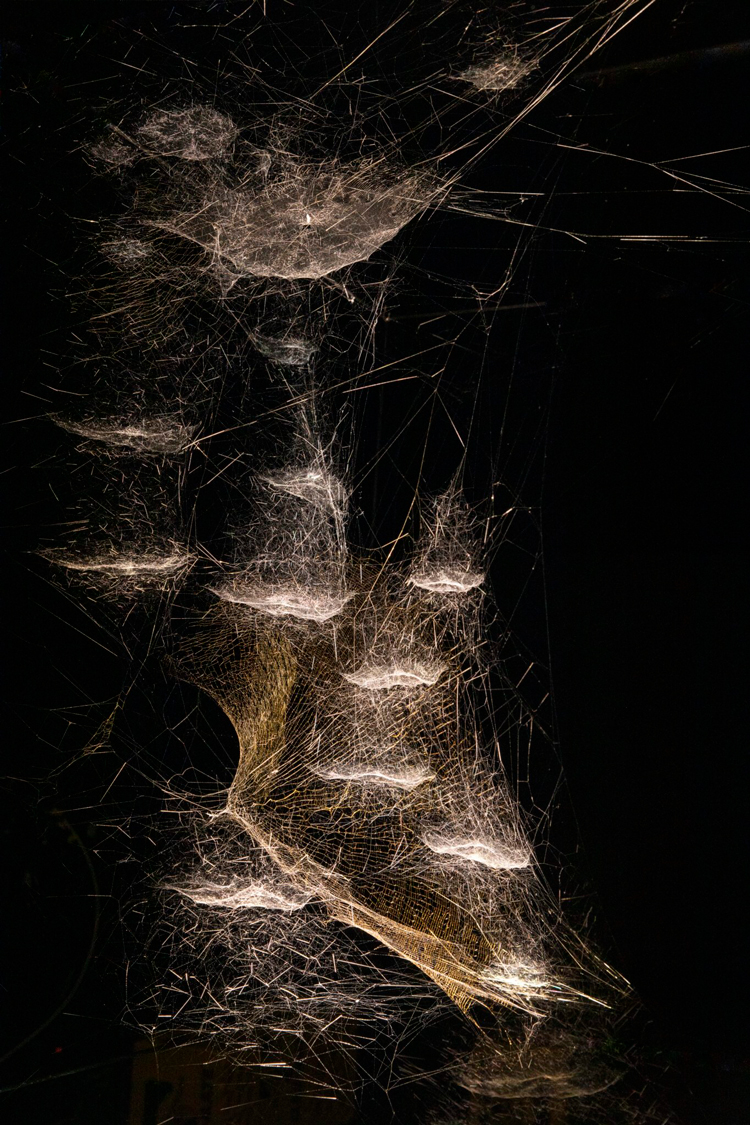
Web.Life 202.3 (detail). Courtesy the spider/webs. Photo: Studio Tomás Saraceno.
But it is the next room of the show that is truly wondrous. Saraceno has filled it with vast spider webs, woven by spiders between branches then shipped over to the gallery. Everything about these objects is remarkable. Spotlit in a darkened room, they gleam as if lit from within. They look like the ghosts of megastructures, spectral clouds and celestial formations. Their forms are each unique, as if spider-kind is unwilling to repeat itself. They also amaze with their fragility. For all their scale and intricacy, these incredible creations of arachnid creativity could all-too-easily brushed away into non-existence. Let us hope the Serpentine’s cleaning staff have been well-briefed.
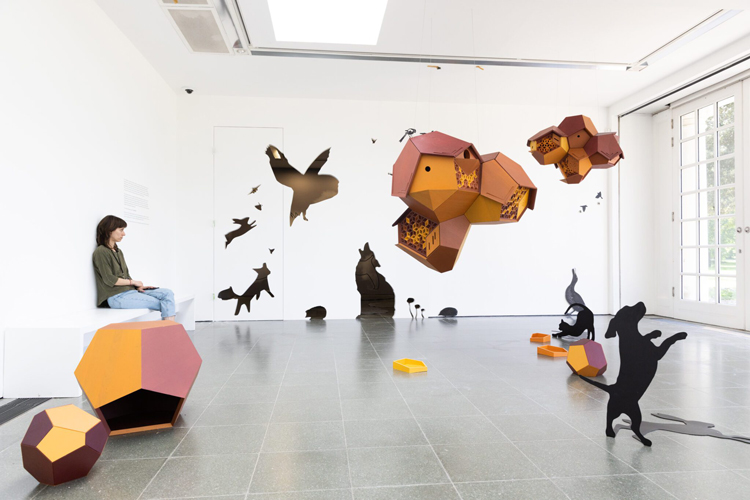
In the shadows, 2023, & Cloud Cities: Species of Spaces and Other Pieces*, 2023. Installation view at Tomás Saraceno In Collaboration: Web(s) of Life, Serpentine, London, 2023. Photo: Studio Tomás Saraceno.
After this cosmic encounter with spidery sublimity, the exhibition crashes down to earth. One room is devoted to Cloud Cities: Species of Spaces and Other Pieces (2023), a set of sculptures intended to become homes for the non-human animals of Kensington Gardens (there is also an area for children, Cloud Imagination, 2023, accessed through an aperture too small for most adults). The entire north wall of the gallery has been opened to allow in the wildlife. Time will tell if they manage to encourage the sort of interspecies encounters Saraceno hopes for. But even if foxes, birds, butterflies and hedgehogs fail to commingle, the sculptures serve as an interesting experiment, imagining what a city might look like if it were not designed for humans first. They are also a little quaint. Exploring them feels rather like walking around outside someone else’s house at night and staring in the windows.
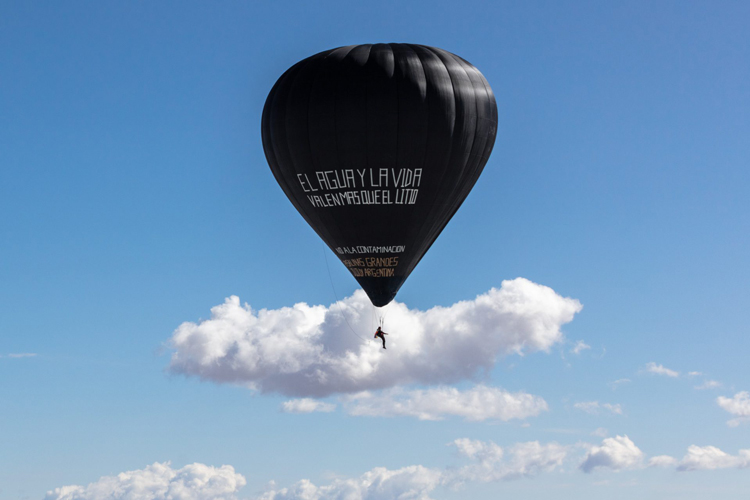
On 25 January 2020, 32 world records, recognised by FAI were set by Aerocene with Leticia Noemi Marques, flying with the message 'Water and Life are Worth More than Lithium' written with the communities of Salinas Grandes and Laguna de Guayatayoc, Jujuy, Argentina. This marks the most sustainable flight in human history. Fly with Aerocene Pacha, a project by Tomás Saraceno for an Aerocene era, was produced by the Aerocene Foundation and Studio Tomás Saraceno. Supported by Connect, BTS, curated by DaeHyung Lee.
The pavilion’s central hall is given over to the film Fly with Pacha, Into the Aerocene (2023), directed by Saraceno with Maximiliano Laina. This is a work with a long backstory. In 2012, Saraceno founded another research network, Aerocene, which investigates “planetary mobility and ethics”. In 2020, in collaboration with the communities of the Salinas Grandes and Laguna de Guayatayoc Basin, Argentina, Aerocene launched an aerosolar balloon, the first to be launched without fossil fuels. It was recognised as the most sustainable flight in human history.
The film melds footage of the balloon launch — in woozy inspirational mode — with sobering interviews with the local indigenous community. These are protesting to protect their land from mass lithium mining. Lithium is used in “green” technologies such as phone batteries and electric cars. But its extraction is environmentally destructive and causes drought. Saraceno has used the record-breaking flight of his solar sculpture as a way to raise awareness. It was first flown displaying the message “Water and life are worth more than lithium”, and has since taken a second flight with another phrase. Many artists now work as documentarians, capturing global injustices and displaying them as film installations. The cinematography of Saraceno’s contribution is par for the course. After the webs, it cannot help but seem a little humdrum. Questions remain about the capacity of these works for effecting change. In some cases, it can seem like the artist is instrumentalising the suffering of others to create output.
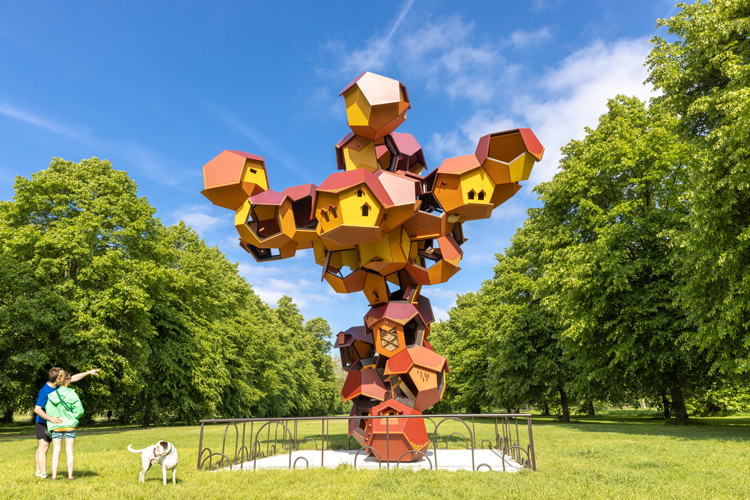
Cloud Cities: Species of Spaces and Other Pieces*, 2023. Installation view at Tomás Saraceno In Collaboration: Web(s) of Life, Serpentine, London, 2023. Photo: Studio Tomás Saraceno.
Saraceno, admirably, does nothing of the sort. He refuses to just observe, but researches and gets involved. He does not jump in and out again, but continues to help the communities he works with and credits them as collaborators – Cloud Imagination, for instance, is not owned by anyone but “stewarded by various parties to advance the Salinas Grandes community’s efforts”. He places his environmentalism over displaying the art. Web(s) of Life is solar-powered and so dependent on the weather; on very cloudy days, the videos may not play. And he has ingenious ways to get even art audiences engaged with the issues he cares about. The installation The Birds Will Keep Calling You (2023) encourages you to hand over your phone while you explore the exhibition, both drawing your attention away from the screen and, later on, focusing attention on the cost of the lithium we carry around. These links and throughlines – you could say they form a web – make Saraceno’s exhibition an unusually thoughtful one.
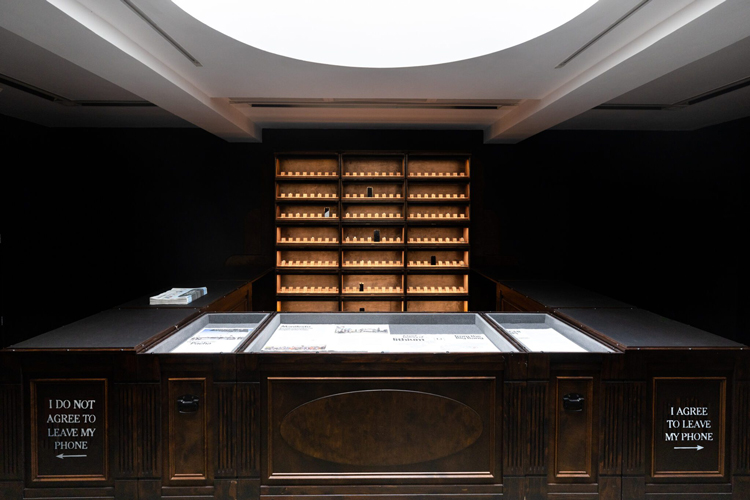
The birds will keep calling you, 2023. Installation view at Tomás Saraceno In Collaboration: Web(s) of Life, Serpentine, London, 2023. Photo: Studio Tomás Saraceno.